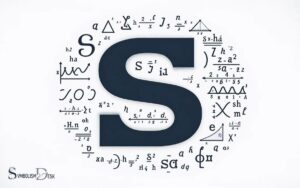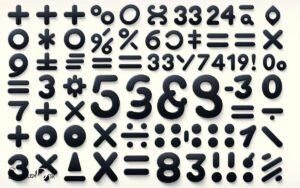Translating Words Into Math Symbols: Addition!
Translating words into mathematical symbols involves the conversion of verbal statements into algebraic expressions or equations.
This skill is foundational in mathematics for solving problems, creating models, and facilitating clear communication.
Key math symbols include addition (+), subtraction (-), multiplication (×), division (÷), equals (=), inequalities (<, >), and variables (letters representing numbers).
The translation from words to math symbols requires a comprehension of language used in math problems and an understanding of the corresponding symbols.
Here’s a brief overview:
Example: The phrase “the sum of a number and seven” translates to the algebraic expression “x + 7”.
Efficient translation from words to math symbols streamlines problem-solving and enhances clarity in mathematical communication.

Key Takeaway
Translating Common Math Phrases to Symbols – Quick Reference Table
| Words in Phrase | Math Symbol | Example Phrase | Mathematical Translation |
|---|---|---|---|
| Sum, Plus | + | Sum of x and y | x + y |
| Difference, Minus | – | Difference between x and y | x – y |
| Product, Times, Of | × | Product of x and 5 | x × 5 |
| Quotient, Divided By | ÷ | Quotient of x and y | x ÷ y |
| Is, Gives, Results In | = | z is the sum of x and y | z = x + y |
| Greater Than | > | x is greater than y | x > y |
| Less Than | < | x is less than y | x < y |
| At Least | ≥ | x is at least 5 | x ≥ 5 |
| Exceeds | > | x exceeds y | x > y |
Importance of Translation in Mathematics
One must recognize the significance of translation in mathematics for ensuring precision and clarity in communicating mathematical concepts.
Translation involves converting mathematical ideas from one form to another, such as from word problems to mathematical equations or from verbal descriptions to algebraic expressions.
This process is crucial as it enables mathematicians to represent real-world problems in a mathematical language, making it easier to analyze and solve them.
Moreover, in a global context, translation facilitates the sharing of mathematical knowledge across different languages and cultures, contributing to the advancement of the field.
Without accurate translation, misinterpretation and confusion can arise, leading to errors in problem-solving and mathematical reasoning.
Therefore, the role of translation in mathematics cannot be understated, as it is fundamental for expressing, interpreting, and understanding mathematical concepts effectively.
Common Math Symbols and Their Meanings
Discussing the meanings of common math symbols is essential for understanding and using mathematical notation accurately.
Here are some common math symbols and their meanings:
- “+” (Plus): This symbol indicates addition, bringing two or more numbers together.
- “-” (Minus): It represents subtraction, denoting the operation of taking one number away from another.
- “×” (Multiplication): This symbol signifies multiplication, showing the process of repeated addition.
- “÷” (Division): It denotes division, the process of splitting a number into equal parts.
Understanding these basic math symbols is crucial for interpreting and solving mathematical problems effectively.
Mastery of these symbols forms the foundation for more complex mathematical operations and expressions. Mastery of these symbols forms the foundation for more complex mathematical operations and expressions. They enable students to recognize patterns, solve equations, and explore abstract concepts with greater clarity. Among these, the symbols of change in math, such as delta (∆) or derivatives, play a crucial role in understanding dynamic processes and relationships, bridging the gap between static problems and real-world applications.
Strategies for Translating Verbal Descriptions
To effectively translate verbal descriptions into math symbols, it is essential to employ precise and clear language that accurately conveys the mathematical relationships being described.
One strategy is to identify keywords that indicate mathematical operations, such as “sum,” “difference,” “product,” or “quotient.” It’s also important to pay attention to words that signify equality, such as “is,” “equals,” or “is equivalent to.”
Breaking down the problem into smaller parts can help in identifying the relationships between different quantities or variables. Visualizing the situation or problem can aid in understanding and translating it into mathematical expressions or equations.
Additionally, being mindful of units and their conversions can ensure that the mathematical representation accurately reflects the real-world scenario.
Finally, practice and exposure to various verbal descriptions can enhance one’s ability to effectively translate them into math symbols.
Examples of Word-to-Math Symbol Translations
Examples of word-to-math symbol translations frequently demonstrate the application of precise language and clear mathematical relationships in various contexts.
Here are some illustrative examples:
- “The sum of a number and 5” translates to ( x + 5 ).
- “Twice a number increased by 3” translates to ( 2x + 3 ).
- “The difference between a number and 8” translates to ( x – 8 ).
- “Three times a number decreased by 2” translates to ( 3x – 2 ).
These examples showcase how word phrases can be accurately represented using mathematical symbols, emphasizing the importance of understanding and effectively applying word-to-math symbol translations.
By interpreting verbal descriptions into mathematical expressions, individuals can effectively solve problems and analyze real-world situations with precision.
Pitfalls to Avoid When Translating to Math Symbols
Avoid falling into common pitfalls when translating verbal descriptions into mathematical symbols to ensure accurate representation and interpretation.
One common pitfall is the incorrect use of variables. It’s essential to clearly define the meaning of each variable to prevent confusion.
Another pitfall is the improper translation of words like “and,” “or,” “less than,” and “greater than” into mathematical symbols.
Misinterpreting these can lead to incorrect equations. Additionally, be cautious when dealing with ambiguous language or vague terms in verbal descriptions, as these can result in inaccurate mathematical representations.
Lastly, ensure that the mathematical symbols accurately reflect the intended relationship between the quantities described in words.
By being mindful of these pitfalls, one can effectively and accurately translate verbal descriptions into mathematical symbols.
Conclusion
The ability to translate words into math symbols is crucial in mathematics. Understanding the meanings behind common math symbols and employing effective strategies for translating verbal descriptions are essential skills for mathematical success.
However, it is important to be mindful of potential pitfalls when translating to math symbols, such as misinterpretation or ambiguity. Mastering the art of word-to-math symbol translation is a valuable skill for any mathematician or student of mathematics.






